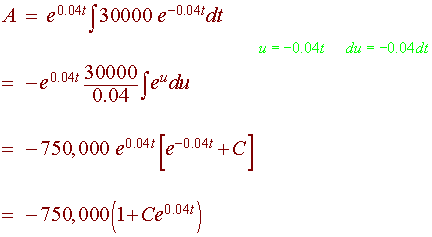First Order Linear Differential Equations
In this section we will concentrate on first order linear differential equations. This means that only a first derivative appears in the differential equation and that the equation is linear. Considering x constant, it can be written in the form
y' = my + b
or setting
m = -p(x) and b = g(x)
this gives
y' + p(x)y = g(x)
Before we come up with the general solution we will work out the specific example
2
y' +
y = ln x
x
The strategy for solving this is to realize that the left hand side looks a little like the product rule for differentiation. The product rule is
(uy)' = uy' + u'y
This leads us to multiplying both sides of the equation by u which is called an integrating factor.
2
u y' + u
y = u
ln x
x
We now search for a u with
2
u' = u
x
or
du
2
=
dx
u
x
Integrating both sides, produces
ln u = 2 ln x = ln(x2)
u = x2 exponentiating both sides
Going back to the original differential equation and multiplying both sides by x2, we get
x2y' + 2x y = x2 ln x
Using the product rule in reverse gives
(x2y)' = x2 ln x
Now integrate both sides. Note that the integral of the derivative is the original. Integrate by parts to get
![]() u
= ln x
dv = x2
dx
u
= ln x
dv = x2
dx
du
= 1/x dx
v =
1/3 x3
![]()
Hence
1
1
x2y =
x3 ln x -
x3 + C
3
9
1
1 C
y =
x ln x -
x +
Divide by x2
3
9 x2
Now we will derive the general solution to first order linear differential equations.
Consider
y' + p(t)y = g(t)
We multiply both sides by u to get
uy' + up(x)y = ug(x)
We now search for a u with
u' = up(x)
or
du
= p(x) dx
u
Integrating both sides, produces
![]()
![]() exponentiating
both sides
exponentiating
both sides
Going back to the original differential equation and multiplying both sides by u, we get
u y' + u p(x) y = u g(x)
(u y)' = u g(x)
![]()
Solving for y gives
![]()
Exercises
Solve the following differential equations
- y'
+ 3/x y = 1 + x
- y'
- y = 2x y(0)
= 1
- y'
+xy2 = x
- xy'-3y = 3x + 2
Application
You are the foundation director of the college and oversee an endowment fund that has a continuous donation flow of $30,000 per year.. The fund earns 4% interest and cannot be use for scholarships for ten years. Determine how much money will be in the fund in ten years if currently there is $100,000 in the fund.
Solution
We see that the rate of increase of the fund is the sum of the interest and the donations. We can write the differential equation as
A' = 0.04A + 30,000
where A is the amount of money in the account at time t. Subtracting, write
A' - 0.04A = 30,000
This is a linear first order differential equation. The integrating factor is
![]()
So that the solution is

Now we use the fact that the fund currently (t = 0) has A = $100,000.
100000 = -750000(1 + Ce0.04(0))
100000 = -750000(1 + C)
C = -1.1333
We can now find out how much will be in the account in t = 10 years.
A(10) = -750000(1 - 1.1333e0.04(10)) = 741,828
The account will be worth $741,828 in ten years.
Back to the Math 117 Home Page
Back to the Math Department Home
e-mail Questions and Suggestions